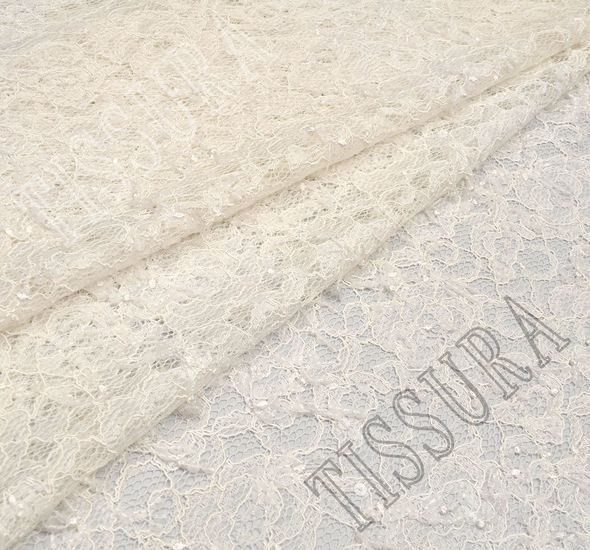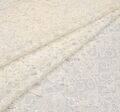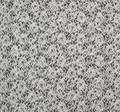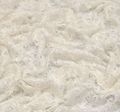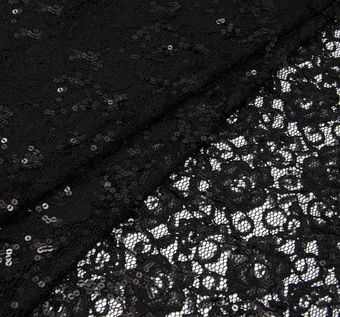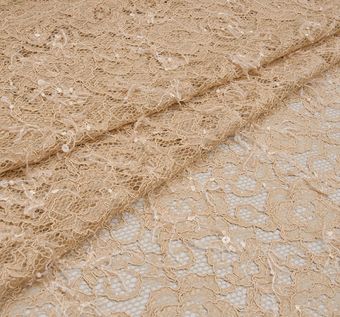Sequined Corded Lace
1 m = 1.1 yd
Characteristics
| Composition: | 62% Viscose 32% Polyester 6% Nylon |
| Weight: | 240 g/m² |
| Width: | 135 cm |
| Manufacturer: | HOH |
| Country: | Austria |
| Categories: | Bridal, Dresses, Skirts |
This embroidered ivory lace features an all-over floral pattern, outlined with matching soutache cord. It is decorated with matt sequins strung on fine threads and attached neatly to the ground. Due to its balanced content which comprises a distinctive blend of premium fibers, the sheer lace is quite durable and keeps its original appearance for a long time.
What is Lace?
Lace has a disputable origin since it evolved from other techniques. This beautiful openwork can be either English or French legacy. Even if it was Italian, the world would love it just as much. Handcrafted and machine-made, it was widespread in Europe by the 16-th century. Lace is named after the Latin word laqueus, which means “noose”. Equally valued by the early Catholic Church clergy and city fashionistas, this fabric has a number of production techniques
- knotted lace, such as macramé and tatting,
- cutwork, or whitework,
- machine-made lace,
- chemical lace,
- crocheted lace,
- tape lace,
- knitted lace,
- needle lace,
- bobbin lace.
These days not all these varieties are widespread. Different kinds of lace keep falling in and out of fashion, but some are here to stay. When it comes to high-quality dress material, corded lace is one of the most popular choices both for evening dresses and day dresses – all because of its look, feel and hand.
How to Sew with Embroidered Lace?
Lace, as well as many other fabrics, has its underlying potential problems when it comes to sewing. Due to its gossamer-like structure, this fabric can be a real challenge for those who have just started their sewing lessons. There are several tips that can help you turn this embroidered lace into a beautiful piece of clothing.
1. Mind the side. Sometimes lace looks the same on both sides, but in most cases, they differ. One should mind the face side, especially while working with multiple lengths of lace fabric. It’s a good idea to use stickers or removable tailor’s chalk to indicate it.
2. Symmetry is key. While designing the dress, consider the ornament direction and place the fabric accordingly. Estimate the length of the dress so as to place scallops symmetrically
3. Always prepare your fabric before cutting. Steam ironing might work for cotton lace, but it all depends on the type of fabrics – mostly only dry-cleaning is allowed. The best strategy is to follow the manufacturer’s guidelines.
4. If you need to secure your fabric, opt for fine and sharp silk pins. You may also use weights to keep it in place.
5. Sharp scissors are a key to success. We recommend using special scissors or a rotary cutter for cutting lace. Use tone-on-tone thread to avoid the contrast with delicate lace fabric. Viscose thread and thin needle are essential for handworks and beadworks.
6. Overlap two pieces of lace to hide your seam. Carefully match the basting marks between the two pieces. It depends on the motif, but sew the new seam as close to your basted line as you can. Trim away excess at the overlap edges. You can pin and baste around the lapped seam and test until you're satisfied with how it looks.
7. Pressing is quite tricky, too. Before pressing, cover lace fabric with some kind of protection, like a thick cotton towel. Or, you could also use a special iron shoe.
Bridal Lace
Bridal lace is a luxuriously designed lace that has traditionally been used in wedding dresses. Created for one of the most festive and celebrated occasions in woman’s life, this fabric often comes with opulent decorations such as sequin, bead, pearl or rhinestone embroidery.
Some of the most beautiful designs are represented by Lyon, corded, guipure, macrame, cotton and Chantilly lace fabrics. The color palette of bridal laces is all about pastels: white, beige, off-white and ivory, which recalls to purity and solemnity.
Created by such iconic European manufacturers as Sophie Hallette, Riechers Marescot and Solstiss, bridal lace fabrics are the epitome of luxury worthy of crowned heads.
Corded Lace
Corded lace fabrics are renowned for their raised patterns outlined with soutache cord. These fabrics are also known as Alencon lace and are often used in bridal and evening fashion. Corded lace is ideal for overlays and looks especially chic paired with organza or silk satin. Opaque or see-through, this lace type has a textured surface.
Corded laces are supplied by such well-known French and Austrian manufacturers as Sophie Hallette, Riechers Marescot, Solstiss and HOH. Chosen by the world's leading fashion houses, they are often transformed into iconic masterpieces of haute couture.
Embroidered Lace
Embroidered lace fabric is a luxury type of cloth embellished with beads, sequins, feathers, ribbons, rhinestones, etc. This lace is often selected for opulent special occasion dresses, evening and bridal gowns. One can choose between corded, guipure or Chantilly lace decorated with raised stitching or sparkling décor. The production of these fabrics is often time-consuming, as not all designs can be created by complex machinery. For some of them, handwork is a must.
Embroidered lace fabrics are manufactured by prominent brands that have been specialising on luxury fabrics creation for years. Those are such haute couture fabric producers as Jakob Schlaepfer, Forster Rohner, Aldo Bianchi, Riechers Marescot, Sophie Hallette, Solstiss and HOH.
Payment and Delivery Terms
We offer worldwide shipping on all items in Tissura online shop. Delivery to USA, UK, UAE, Australia and rest of the world.
We accept bank transfers and payments by credit and debit cards. Learn more about our payment and delivery terms.
Fabric by the Yard: Measurement Conversion
All fabrics on our website are priced by the running meter. The term "running meter" or "linear meter" is used in the fabric industry.
To convert meters to yards, use the conversion factor 0.9144. In other words,
1 Yard = 0.9144 Meters
1 Metre = 1.0936 Yards
